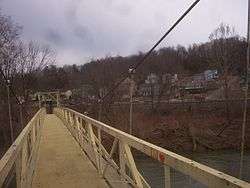Hyde Park, Pennsylvania
| Hyde Park, Pennsylvania | |
|---|---|
| Borough | |
|
A portion of the borough as seen from the pedestrian bridge. | |
 Hyde Park, Pennsylvania | |
| Coordinates: 40°37′54″N 79°35′23″W / 40.63167°N 79.58972°WCoordinates: 40°37′54″N 79°35′23″W / 40.63167°N 79.58972°W | |
| Country | United States |
| State | Pennsylvania |
| County | Westmoreland |
| Incorporated | September 3, 1898 |
| Government | |
| • Type | Borough Council |
| Area | |
| • Total | 0.3 sq mi (0.8 km2) |
| • Land | 0.2 sq mi (0.5 km2) |
| • Water | 0.1 sq mi (0.3 km2) |
| Elevation | 801 ft (244 m) |
| Population (2010) | |
| • Total | 500 |
| • Density | 2,163.7/sq mi (835.4/km2) |
| Time zone | Eastern (EST) (UTC-5) |
| • Summer (DST) | EDT (UTC-4) |
| Zip code | 15641 |
Hyde Park is a borough in Westmoreland County, Pennsylvania, United States. The population was 500 at the 2010 census.
Pedestrian Footbridge
Located between the borough of Hyde Park and the borough of Leechburg, the footbridge, locally known as "The Walking Bridge" is a suspension bridge that stretches 600 feet across the Kiskiminetas River. It is one of the longest pedestrian suspension footbridges in the United States, and one of the only pedestrian bridges to connect two counties, in this case, Westmoreland and Armstrong counties. The official name of the bridge is the Armstrong County Bridge #13.
Geography
Hyde Park is located at 40°37′54″N 79°35′23″W / 40.63167°N 79.58972°W (40.631729, -79.589618).[1]
According to the United States Census Bureau, the borough has a total area of 0.3 square miles (0.78 km2), of which, 0.2 square miles (0.52 km2) of it is land and 0.1 square miles (0.26 km2) of it (20.69%) is water.
It is surrounded on three sides by the Kiskiminetas River. There is also a walking bridge connecting Hyde Park to Leechburg, Pennsylvania. An original wooden bridge was built in 1920 on old piers from a railroad bridge that was destroyed in early 1900s flooding. The current metal bridge was built in 1955 and is 450 feet long.
Demographics
| Historical population | |||
|---|---|---|---|
| Census | Pop. | %± | |
| 1900 | 312 | — | |
| 1910 | 315 | 1.0% | |
| 1920 | 743 | 135.9% | |
| 1930 | 736 | −0.9% | |
| 1940 | 717 | −2.6% | |
| 1950 | 758 | 5.7% | |
| 1960 | 683 | −9.9% | |
| 1970 | 729 | 6.7% | |
| 1980 | 633 | −13.2% | |
| 1990 | 542 | −14.4% | |
| 2000 | 513 | −5.4% | |
| 2010 | 500 | −2.5% | |
| Est. 2015 | 480 | [2] | −4.0% |
| Sources:[3][4][5] | |||
As of the census[4] of 2000, there were 513 people, 212 households, and 149 families residing in the borough. The population density was 2,163.7 people per square mile (825.3/km²). There were 231 housing units at an average density of 974.3 per square mile (371.6/km²). The racial makeup of the borough was 99.61% White and 0.39% African American. Hispanic or Latino of any race were 0.78% of the population.
There were 212 households out of which 26.9% had children under the age of 18 living with them, 57.5% were married couples living together, 8.0% had a female householder with no husband present, and 29.7% were non-families. 25.9% of all households were made up of individuals and 9.9% had someone living alone who was 65 years of age or older. The average household size was 2.39 and the average family size was 2.87.
In the borough the population was spread out with 22.2% under the age of 18, 5.7% from 18 to 24, 25.3% from 25 to 44, 27.5% from 45 to 64, and 19.3% who were 65 years of age or older. The median age was 43 years. For every 100 females there were 99.6 males. For every 100 females age 18 and over, there were 92.8 males.
The median income for a household in the borough was $34,722, and the median income for a family was $39,519. Males had a median income of $31,979 versus $21,250 for females. The per capita income for the borough was $15,214. About 10.2% of families and 14.1% of the population were below the poverty line, including 25.2% of those under age 18 and none of those age 65 or over.
References
- ↑ "US Gazetteer files: 2010, 2000, and 1990". United States Census Bureau. 2011-02-12. Retrieved 2011-04-23.
- ↑ "Annual Estimates of the Resident Population for Incorporated Places: April 1, 2010 to July 1, 2015". Retrieved July 2, 2016.
- ↑ "Census of Population and Housing". U.S. Census Bureau. Archived from the original on May 11, 2015. Retrieved 11 December 2013.
- 1 2 "American FactFinder". United States Census Bureau. Archived from the original on September 11, 2013. Retrieved 2008-01-31.
- ↑ "Incorporated Places and Minor Civil Divisions Datasets: Subcounty Resident Population Estimates: April 1, 2010 to July 1, 2012". Population Estimates. U.S. Census Bureau. Archived from the original on June 17, 2013. Retrieved 11 December 2013.

